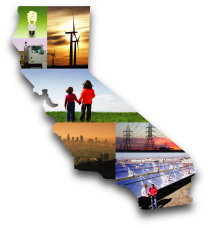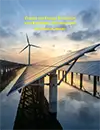Center for Energy Efficiency and Renewable Technologies
Center for Energy Efficiency and Renewable Technologies
Providing global warming solutions for California and the West.

Join CEERT Email Newsletter
CEERT programs
In energy, policy matters. Public agencies at all levels make decisions affecting which energy resources and technologies receive public and private investment, how and where that energy is produced and distributed, what its public-health and air-quality impacts are, and what it all ends up costing us.
Even when there is clear policy direction from the top, as with California’s Renewable Portfolio Standard (RPS), focused implementation oversight is necessary to ensure that the many different parties with fragmented responsibilities act in concert to achieve the big-picture goal. Broadening public support for cleaner energy supplies and promoting multi-agency and stakeholder cooperation in policy-implementation efforts are fundamentals of our work.
That work now takes us before all of the traditional energy rule-making bodies, and to wherever the next troubleshooting target or opportunity appears. To find out more, follow the links to our program pages:
Affordability
This year, CEERT has added energy affordability to our top goals. We are in the ongoing process of meeting with key parties to assess major hurdles and possible solutions standing in the way of affordability, including conversations with The Utility Reform Network (TURN), Conservation Strategy Group, and Clean Air Task Force. CEERT and CPC hope to form a coalition on the matter in the coming months and host regularly occurring roundtables to brainstorm and advocate for potential policy to be pushed in next year’s legislative session. Learn more about how these ideas are taking shape in California.
Low-Carbon Grid
CEERT’s Low-Carbon Smart Grid Program promotes the integration of large amounts of renewable energy on the grid by tracking and intervening in crucial proceedings at the California Independent System Operator (CAISO) and other agencies. We also seek to foster joint operating agreements between the CAISO and the state’s municipal and investor-owned utilities, and promote coordination and consolidation of the Balancing Areas in our state and region as a low-cost means of integrating renewable power. The issues are often highly technical, but have enormous impact on the price of renewable energy projects and their access to the transmission and distribution system. Learn more about how these ideas are taking shape in California.
Discussions With Government Officials
CEERT frequently meets with state and local administrative officials to discuss clean-energy and climate issues, such as permitting and siting for renewable generation projects and the advancement of new, clean, cutting-edge technologies. Learn more about CEERT’s communication with government.
Advocacy at the California Public Utilities Commission (CPUC)
CEERT’s Regulatory Counsel Sara Steck Myers and Associate Regulatory Attorney Megan Myers act as advocates and intervenors before the CPUC and other regulatory agencies to ensure fairly pricing for clean power, improve renewable energy procurement planning, and strengthen implementation of the state’s mandated climate and clean-energy goals. CEERT is helping lead the fight for innovative policies that reflect the true value, costs, and benefits of clean, renewable energy. Learn more about what is being accomplished and at stake in the RPS regulatory implementation process.
Long-Duration Energy Storage
Long-duration energy storage projects are fast-starting, quick-ramping, high-capacity resources that can help balance peak loads and enhance clean-energy resources’ ability to meet the needs of the electric grid. Strategic bulk-storage investments will allow us to park surplus renewable energy for times of low supply, and provide flexibility to the grid without burning fossil fuels. CEERT vigorously advocates for long-duration energy storage at the CAISO and in CPUC procurement rulemakings. Learn more about our Long-Duration Energy Storage program.
Advocacy at the California Air Resources Board (CARB)
California’s landmark Global Warming Solutions Act of 2006 (AB 32) requires close collaboration by the Air Resources Board, Public Utilities Commission, Energy Commission, and Independent System Operator to implement the reduction of greenhouse-gas (GHG) emissions in order to obtain 100% of the state’s electricity from zero-carbon sources by 2045. CEERT’s Climate Program works to strengthen CARB’s GHG Scoping Plan and to lower the current target for GHG emissions. Learn more about Advocacy at the California Air Resources Board (CARB).
Transmission Planning and Development
Transmission is to renewable energy resources what the transcontinental railroad was to opening up the West. We need to connect California’s renewable resource-rich regions—wind from Tehachapi, geothermal and wind from the Imperial Valley, and solar power from the Mojave Desert and the Central Valley—to the large coastal urban load centers of the state where it is needed. Making this vital connection will require a series of massive, multibillion-dollar investments in new transmission infrastructure. In conjunction with the California Energy Commission, we have been promoting a unique stakeholder collaboration project to expedite planning and development of vital transmission projects. Learn more about what is being done to wire California’s renewable resources to the electricity market.
LADWP, SMUD, And Other Municipal Utilities
CEERT continues our long-time work with municipal, publicly owned utilities such as the Los Angeles Department of Water and Power (LADWP), Sacramento Municipal Utility District (SMUD), and Riverside Utilities to reduce their dependence on fossil-fueled power and increase reliance on clean energy resources. Learn more about CEERT’s LADWP, SMUD, And Other Municipal Utilities Activities.
Clean Transportation and Alternative Fuels
Gasoline and diesel transportation fuels represent a major share of America’s most pernicious air pollution, water-borne toxins, and climate emissions. CEERT has been working to clean up CO2 from cars and trucks, promote electric and hydrogen fuel-cell vehicles and their recharging/refueling infrastructure, and bring about smarter transportation and development planning. Learn more about the need for and efforts to promote clean transportation and the use of alternate fuels.
Advocacy at the California Energy Commission (CEC)
CEERT is actively taking part in the CEC’s Integrated Energy Policy Report (IEPR), which is focusing on transportation issues and on transmission, the impacts of land-use planning efforts, the use of environmental screens in energy procurement, and the expansion of renewable energy. We are also participating in the CEC-based interagency group working to implement SB 100’s goals of 100% zero-carbon energy for the state. Learn more about our advocacy at the California Energy Commission (CEC).
Geothermal Development and Lithium Recovery
Lithium can be recovered from the brine that geothermal power plants pump from deep in the earth. Pilot projects have demonstrated that this extractive method is a significantly more cost-effective and less environmentally damaging way to produce lithium, an essential element for auto and energy-storage batteries. Lithium extraction would greatly boost the economic prospects of geothermal energy plants by creating a substantial new revenue stream, and could stimulate a new generation of plants in the Known Geothermal Resource Area by Imperial Valley’s Salton Sea. CEERT has helped develop and execute a Knowledge Transfer Plan to advance the commercial viability of this technology, and is working on procurement strategies for new geothermal development to support the future expansion of the lithium industry. Learn more about our advocacy with Geothermal Development and Lithium Recovery.
Renewable Hydrogen
To achieve California’s economy-wide decarbonization goals, California must explore alter-natives to fossil fuels where electrification is not practical or cost-effective. Renewable hydrogen has the potential to fill specific niches in the transportation, electricity, and industrial sectors, and can help meet California’s growing reliability need as a form of long duration or seasonal storage for renewable energy. Learn more about our advocacy with Renewable Hydrogen.

